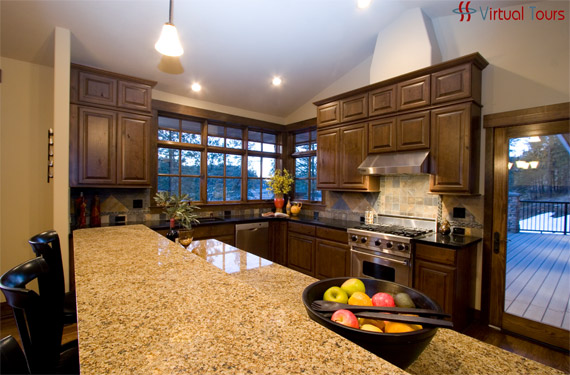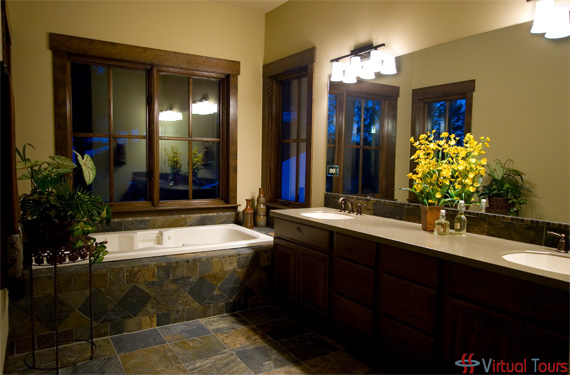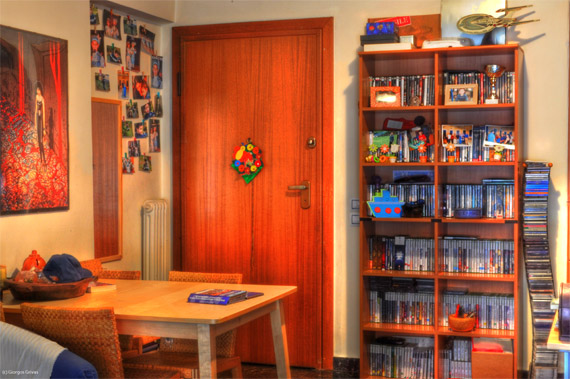There are beautiful homes with superb design, architecture, and lighting. And there are homes that lack all three of these. The goal of a residential interior photographer is to make even the ugliest home look appealing. This guide will cover how to choose the right equipment, use proper lighting, prep a home for a shoot, and composition.

"Interior Kitchen" captured by Aaron Simonsen (Click Image to See More From Aaron Simonsen)
What Equipment Is Best?
For residential interior photography the home will dictate what equipment you need. Some homes designed by great architects are designed specifically with natural lighting in mind and won?t need much extra lighting. Other homes, however, will. Always plan for the worst.
The bare essentials you?ll need for interior photography include a tripod, electronic flash, and non-distorting lenses. Wide angle is fine as long as they aren?t too wide. If you can, get architecture specific lenses. Try using prime lenses over zoom lenses as this will minimize curvature.
Faster lenses are best as interior photography will have much less available light to work with.
Lighting Basics
Great architects understand the importance of light and design houses around this. If you are fortunate enough to have a well designed lighting system you might be able to get away with only using existing light.
The first step is to turn on all the lights in the house. This will add more depth and color variance to your photos. Be sure that the lights do not show up as reflections in pictures, windows, mirrors, or other reflective surfaces.
Often you?ll need to use external lighting such as flashes or strobes to balance the natural and artificial light. A simple tactic is to replace the incandescent bulbs with more powerful tungsten bulbs. These have a higher output and are more consistent in color temperature with outdoor lighting.
When using a portable flash, it is best not to point the light directly at your scene. Instead, aim it at a wall or ceiling. This will diffuse and spread the light throughout the entire room. Use caution with colored walls as the color may transfer to the light.

"Interior Bathroom" captured by Aaron Simonsen (Click Image to See More From Aaron Simonsen)
Bright and large windows often cause various problems in an interior shoot. They distract the viewer and can cause exposure problems. Planning your shoot when the sun isn?t at its strongest or entering directly into the window is an easy solution to this.
Room Preparation
For residential interior photography the goal is to present an attractive, beautiful home. You?d be quite lucky to find a home with everything perfectly staged and orderly. Often you?re going to want to rearrange furniture and tidy up the area.
Every room has a key element that you will want to feature prominently in your photos. Moving around objects is a great way to lure viewers eyes to these elements. Simply placing bright objects (like a red vase) on these key elements (fireplaces, stairs, grand piano, etc) will make them stand out from other objects in the room.
Composition
After you?ve completed all the preproduction phrases of interior photography, now comes the actual photo taking! The following are a few tips for taking better residential interior photos.
Be Spacious
To make photos appear more spacious be sure to avoid shooting straight at walls. This will make the photo look flat and can also warp the perspective. Instead, shoot into the corners of rooms. This will create more depth and make the room appear larger. Photographing from a lower angle and with a wider angled lens is also a great way to increase the perceived size of the room.
Choose Attention Grabbing Areas
There is no way to photograph a room in one picture (besides photo stitching). When you photograph a room select the interesting parts. Choose objects of importance or parts of the room with more interesting architecture.

"House Interior" captured by George Grivas (Click Image to See More From George Grivas)
Keep the Lines Straight
Be sure that the vertical and horizontal lines in your photos are straight. Crooked lines are signs of poor technical skills and will detract from the image.
Know Your Goal
Are you photographing the house to feature the architectural design or the ambience? Understand your goals for the photo shoot and compose accordingly.
About the Author:
Alphonso is a home inventory photographer located in Orange County, California. He loves design, art, and anything creative.
For further training on interior composition in architecture photography we recently featured this video:
For further training on photographing the exterior of a real estate location, here is a helpful video tutorial:
Best of luck in your real estate photography ventures.
Source: http://www.picturecorrect.com/tips/real-estate-photography-tips/
westminster dog show valentines day cards hallmark grammy winners obama budget woolly mammoth stacy francis
No comments:
Post a Comment
Note: Only a member of this blog may post a comment.